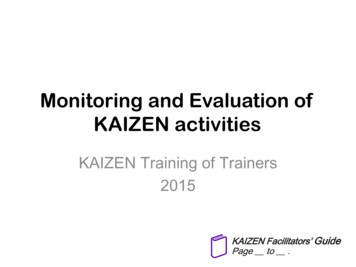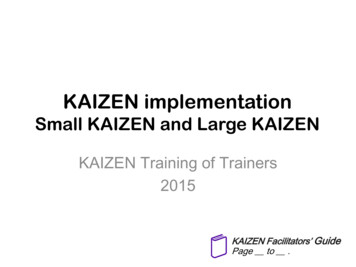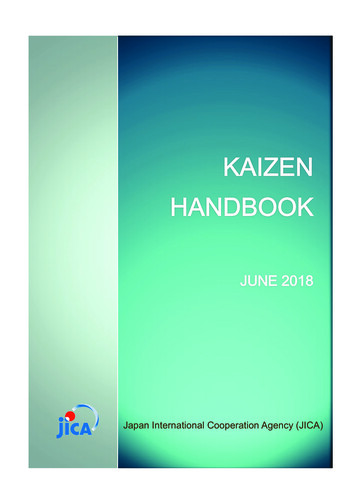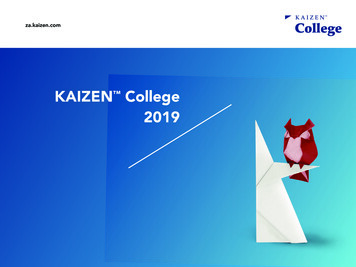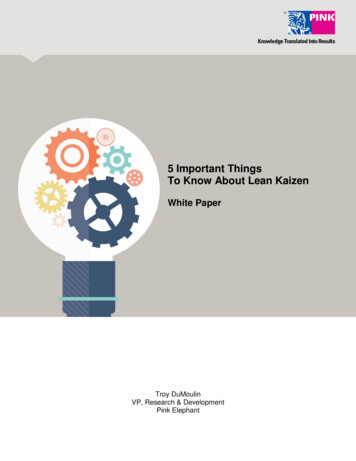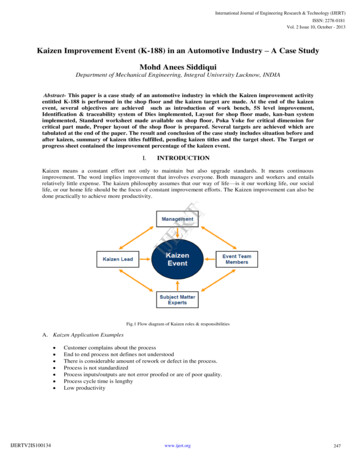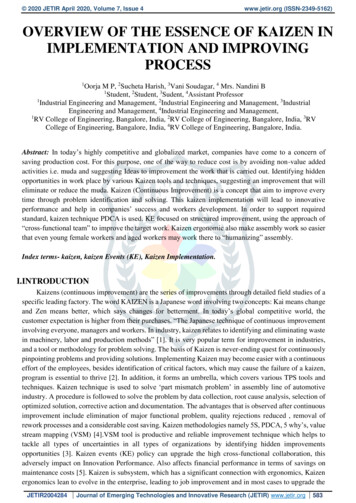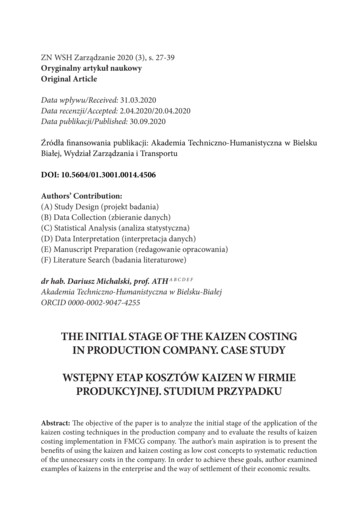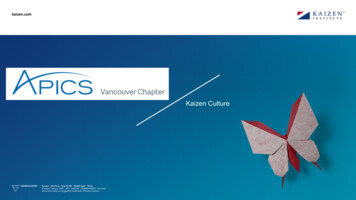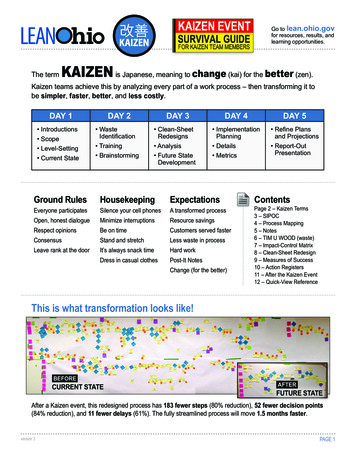
Transcription
Go to lean.ohio.govfor resources, results, andlearning opportunities.The termKAIZEN is Japanese, meaning to change (kai) for the better (zen).Kaizen teams achieve this by analyzing every part of a work process – then transforming it tobe simpler, faster, better, and less costly.DAY 1 Introductions Scope Level-Setting Current StateDAY 2 WasteIdentification Training BrainstormingDAY 3 Clean-SheetRedesigns Analysis Future StateDevelopmentDAY 4DAY 5 ImplementationPlanning Details Metrics Refine Plansand Projections Report-OutPresentationGround RulesHousekeepingExpectationsOpen, honest dialogueMinimize interruptionsResource savingsRespect opinionsBe on timeCustomers served fasterConsensusStand and stretchLess waste in processLeave rank at the doorIt’s always snack timeHard workDress in casual clothesPost-It NotesEveryone participatesSilence your cell phonesA transformed processChange (for the better)ContentsPage 2 – Kaizen Terms3 – SIPOC4 – Process Mapping5 – Notes6 – TIM U WOOD (waste)7 – Impact-Control Matrix8 – Clean-Sheet Redesign9 – Measures of Success10 – Action Registers11 – After the Kaizen Event12 – Quick-View ReferenceThis is what transformation looks like!BEFORECURRENT STATEAFTERFUTURE STATEAfter a Kaizen event, this redesigned process has 183 fewer steps (80% reduction), 52 fewer decision points(84% reduction), and 11 fewer delays (61%). The fully streamlined process will move 1.5 months faster.version 3PAGE 1
Go to lean.ohio.govfor resources, results, andlearning opportunities.Words you’ll hear (and use) during the Kaizen eventconsensus: Agreement in which all members of the group publicly statethat they will actively support the decision, even if it might not be the firstchoice for some in the group.cycle time: The length of time, on average, that it takes to complete astep or set of steps within a process. Sometimes referred to as touch time.5S Safety: A method for creating and maintaining an organized,high-performance workplace. 5S stands for sort, straighten, shine,standardize, sustain.lead time: The average time it takes to meet a customer request ordemand – from the very start of the process to the end. This includestime when the unit is being actively worked on, plus wasted time dueto delays, loopbacks, rework, and others forms of waste. (See TIM UWOOD) Also known as throughput time or turnaround time.Pareto Principle: The observation that for many events, roughly 80% of the effects come from 20%of the causes. Also known as the law of the vital few.poka-yoke: Any effort to eliminate the root causes of defects, so that rework-generating problems don’toccur in the first place. Also known as defect prevention or mistake-proofing. Often used with forms.round-robin: Getting comment from everyone in a group, with one person speaking, then the next, andthen the next – until all voices are heard.SIPOC: Stands for suppliers, inputs, process, outputs, and customers. You obtain inputs from suppliers,add value through your process, and provide an output that meets or exceeds customer requirements.swim lanes: Separate rows on a process map that indicate separate functions.TIM U WOOD: Acronym used to remember the eight forms of waste: transportation, information/inventory, motion, underutilization, waiting, overproduction, overprocessing, and defects.value-added, or VA: Work activities that transform information into services and products the customer iswilling to accept. To qualify as value-added, an activity must meet these three requirements: (1) Done rightthe first time, with no defects. (2) Transformational in that it adds form or function. (3) Customer is willing topay for it. Typically, just 1-5% of a process is value-added.non-value-added, or NVA: Consumes resources, does not contribute directly to service, and is notimportant to the customer.non-value-added but necessary, or NVAN: Not important to the customer, but the work activities/steps are required by statute or law.waste: Any activity that uses resources but does not create value for the customer. (See TIM U WOOD)version 3PAGE 2
Go to lean.ohio.govfor resources, results, andlearning opportunities.SIPOCSUPPLIERSStart hereINPUTSPROCESSOUTPUTSWho provides inputs What resources do youthat are needed to make need to perform this What are the 5-7 majorthis process work?process?milestones that makeCan include people,Can include materials,up this process?other offices, agencies,organizations, etc.supplies, information,authorization, services, etc.CUSTOMERSWhat is producedby this process?Can include services,products, information,decisions, etc.Who benefitsfrom this process?Example: SIPOC in actionSIPOC stands for suppliers, inputs,process, outputs, and customers.In one of the first steps of everyKaizen event, the team developsa SIPOC to establish a commonunderstanding of the big picture.The SIPOC shown here was createdduring a Kaizen event at thePublic Utilities Commission of Ohio.Mail renewalto motorcarrierversion 3Motor carrier mitissued, infoupdatedPermitreceived bymotor carrierPAGE 3
Go to lean.ohio.govfor resources, results, andlearning opportunities.PROCESS MAPPING is all about making the invisible visible.By creating a process map, you will: Get a clear and detailed visual of what is occurring in the process Create a common understanding Identify all stakeholders involved in the process Identify process handoffs and loopbacks Identify waste and value-added activitiesProcess map key:Different functional areas of processBeginning and end points of the processAny activity where work is performed in the processDecision point: Steps in the process whereinformation is checked against establishedstandards and a decision is made on what to donext (must have two or more different paths) One voice Write tasks in “one noun, one verb”format, or “one verb, one noun” Stay at a consistent level Start by identifying the functionalarea that starts the process Detail the tasks, decisions, anddelays in each functional area Follow a “swim lane” model Draw in your swim lane linesDelay: Any time information is waiting beforethe next task or decision occurs in the process(examples: in-baskets, batching, multiple approvals) Connect steps with arrowsConnects tasks performed by the same person orarea, but without any physical movement occurring Who starts this process?Indicates physical movement of information, items,etc. from one person or function to anotherIndicates electronic movement of information fromone person or function to anotherversion 3Process mapping tips:Process mapping questions: How does the process start? And then what ? What happens next ? Are we in the weeds? If I am the customer, I do ?PAGE 4
Go to lean.ohio.govfor resources, results, andlearning opportunities.NOTESThis is a great source of informationabout all things relating to Lean, Kaizen,and Six Sigma in Ohio state government!While you and your colleagues are developing the current-state process map, you’ll likely come upwith ideas for improvement. Write these below so you’ll have them ready later in the Kaizen event.As the Kaizen event unfolds and you make discoveriesand get ideas, capture your AHAs below.version 3PAGE 5
Go to lean.ohio.govfor resources, results, andlearning opportunities.TTRANSPORTATION Transport from officeto office Transport from floorto floor Transport frombuilding to building Other transportationand ON Employees Finished product Inter-officemovement Storage Office to office Printed in advance Cubicle to cubicle Office space Work in process Going to the copieror scanner In the warehouse Requiring unnecessary info on a form Talent Technology Equipment Going to the fax Going to thestoreroom Reaching BendingWWAITINGOODOVERPRODUCTIONOVERPROCESSING Nonproductive time Making too many Mistakes Waiting for: copier scanner delivery catchup person upstream mail/shipper computer Making in advanceof requests Adding things thatnobody wants Report that nobodyreads Inaccurate Throwing away theexcess Things gettingoutdated “We have to beready” Not cautious, butwastefulversion 3 “Gold plating” The best Better than goodenoughDEFECTS Broken Can’t read Can’t understand Wasted materials Returned Beyond meetingcustomerexpectationsPAGE 6
Go to lean.ohio.govfor resources, results, andlearning opportunities.IMPACT-CONTROL MATRIXWrite down all of yourimprovement ideas.The ideas are discussed and placedon the impact-control matrix.IMPACT13I.II.High ImpactHigh ImpactLow ControlHigh ControlIII.IV.Low ImpactLow ImpactLow ControlHigh ControlCONTROL2version 3All ideas are collected.4The result will look like this, with theideas sorted – and the group movingcloser to clean-sheet redesign.PAGE 7
Go to lean.ohio.govfor resources, results, andlearning opportunities.CLEAN-SHEET REDESIGNMAKE ITTRANSFORMATIONAL Create a new process that issignificantly better than the old one Reduce process steps, costs, and timeby at least 50% Delight the customersTips for designing a new andtransformed process: Design process around value-addingactivitiesExample: Clean-sheet redesign in actionIn the photo,a discussionis under wayregarding anewly createdredesign of theprocess. Thissubgroup is oneof three subgroups (from the Ohio Department of Insurance) that are working simultaneously, each developinga separate clean-sheet redesign.Below are three clean-sheet redesigns from a Kaizenevent at the Ohio Development Services Agency. Ensure that work is performed whereit makes the most sense Provide single point of contact forcustomers and suppliers If the inputs coming into the processnaturally cluster, create a separateprocess for each cluster Ensure a continuous flow of the“main sequence” Reduce waiting, moving, and reworktime Reduce or eliminate batching Reduce checks and reviews Push decision-making down to thelowest reasonable level Build in quality in order to reduceinspection and reworkversion 3PAGE 8
Go to lean.ohio.govfor resources, results, andlearning opportunities.MEASURES OF SUCCESSTimebasedprocessmeasures Lead time (beginning to end)Examples: Measurement in action Cycle time (touch time) Waiting time Time to complete form Motion, travel timeCountbasedprocessmeasures Process steps Handoffs Decision points Loopbacks Delays Customer complaints Number of forms Inventory quantity BacklogOutcomemeasures# Customer satisfaction# Redirected work hoursdue to gains in efficiency# Direct cost savings # Customer cost savings Cost savings can accruefrom reductions in: Imaging, scanningDASHBOARD Paper, forms Printing Postage, shipping Storage, inventory Fuel usage Other supplies Travel Overtime Etc.version 3PAGE 9
Go to lean.ohio.govfor resources, results, andlearning opportunities.ACTION REGISTERSWHATWHOWHENWhat taskor objectiveneeds to beaccomplished?Who will take thelead to ensurethat the teamaccomplishes it?When will thetask begin, andwhen it will becompleted?Example: Action RegistersIn a Kaizen event with the Ohio Board of Nursing, the team developed action registers for IT, consumerinformation, complaint processing, training, communication, and more.version 3PAGE 10
Go to lean.ohio.govfor resources, results, andlearning opportunities.AFTER THE KAIZEN EVENT.Use this action registerto write down yourown action steps.10 WAYS YOU CANWHATWHO ELSEWHENMOMENTUMWhat action stepsare you responsible for?Who else (ifanyone) will youinvolve?When will youbegin andcomplete thisactivity?MAGNIFY THE1. Follow through andbegin implementing youraction items.2. If there’s a briefing forstaff about the Kaizenevent, be sure to attend.Serve as a presenter ifyou have the opportunity.3. If you have co-workerswho weren’t on theKaizen team, fill them in.Over time, involve them inthe change process.4. If you hear comments from colleagues that suggest they’re unclear or mistaken about changes that willresult from the Kaizen event, kindly provide the correct information.5. When there are meetings relating to your Kaizen project, attend and participate.6. Also attend the more formal update meetings to check implementation progress and clarify the nextround of action steps. Update meetings typically occur about 30, 60, and 90 days after the Kaizen event.7. Resist slipping back to your old way of doing things. Go with the new way, knowing that change will bechallenging in the short term but better for everyone in the long term.8. Exercise patience and persistence. After the fast-moving Kaizen event, things at work might seem a bitslow by comparison. Don’t lose your focus. You have a plan – now work the plan.9. If you see that key actions are not being implemented – actions you’re not responsible for but youknow to be important – bring it up with the appropriate person and offer to help.10. Be thoughtfully flexible as implementation unfolds. Keep an open mind and a willingness tomake a good project even better.version 3PAGE 11
Go to lean.ohio.govfor resources, results, andlearning opportunities.KEY TERMS:QUICK-VIEW REFERENCESIPOC:consensus: All teammembers state that they willactively support the decision,even if it might not be the firstchoice for some.SUPPLIERSINPUTSPROCESSWho provides inputs What resources do youthat are needed to make need to perform this What are the 5-7 majorthis process work?process?milestones that makeCan include people,Can include materials,up this process?other offices, agencies,organizations, etc.supplies, information,authorization, services, etc.OUTPUTSWhat is producedby this process?Can include services,products, information,decisions, etc.CUSTOMERSWho benefitsfrom this process?lead time: Average time fromthe start of the process to thefinish.Pareto Principle: Roughly80% of the effects come from20% of the causes.IMPACT-CONTROL:High ImpactHigh ImpactLow ControlHigh ControlPROCESS MAP KEY:swim lanes: Separate rowson a process map that indicateseparate functions.value-added, or VA:Activities that transforminformation into servicesand products the customeris willing to accept and meetthese three requirements:(1) Done right the firsttime, with no defects. (2)Transformational in that it addsform or function. (3) Customeris willing to pay for it.waste: Any activity that usesresources but doesn’t createvalue for the customer. (SeeTIM U WOOD)Different functional areas of processBeginning and end points of the processDecision point: Steps where information is checkedagainst established standards and a decision is made onwhat to do nextDelay: Any time information is waiting before the next taskor decision occurs in the processConnects tasks performed by the same person or area,but without any physical movement occurringIndicates physical movement of information, items, etc.from one function to anotherIndicates electronic movement of information from oneperson or function to anotherACTION REGISTER:What taskor objectiveneeds to beaccomplished?“The measure ofintelligence is theability to change.”– Albert EinsteinWHOLow ImpactLow ImpactLow ControlHigh ControlCONTROLAny task/activity where work is performedWHATversion IMPACTpoka-yoke: Any effort toeliminate the root causesof defects, so that reworkgenerating problems don’toccur in the first place.TIM U WOOD:WHENWho will takeWhen will thethe lead totask begin, andensure thatwhen it will bethe teamcompleted?accomplishes it?MEASURES:Time-based measures Lead time Cycle time Waiting time Time to complete form Motion, travel timeCount-based measures Process steps Handoffs Decision points Loopbacks Delays Customer complaints Number of forms Inventory quantity BacklogOutcome measures# Customer satisfaction# Redirected work hours# Direct cost savings # Customer cost savings PAGE 12
The term KAIZEN is Japanese, meaning to change (kai) for the better (zen). Kaizen teams achieve this by analyzing every part of a work process - then transforming it to be simpler, faster, better, and less costly. DAY 1 DAY 2 DAY 3 DAY 4 DAY 5 Introductions Scope Level-Setting Current State Waste Identification Training

